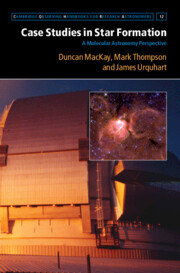Book contents
- Frontmatter
- Dedication
- Contents
- Preface
- List of Acronyms
- Part I Introduction
- Part II Low-Mass Star Formation (LMSF)
- Part III High-Mass Star Formation (HMSF)
- 6 Two HMSFR Surveys Using APEX and NOEMA
- 7 Sagittarius B2
- 8 G29.96 ˗0.02 in W43
- 9 Orion BN/KL
- Part IV Ionisation
- Part V Photodissociation
- Part VI External Galaxies
- Appendices
- List of Research Journal Abbreviations
- References
- Chemical Index
- Subject Index
9 - Orion BN/KL
from Part III - High-Mass Star Formation (HMSF)
Published online by Cambridge University Press: 11 April 2023
- Frontmatter
- Dedication
- Contents
- Preface
- List of Acronyms
- Part I Introduction
- Part II Low-Mass Star Formation (LMSF)
- Part III High-Mass Star Formation (HMSF)
- 6 Two HMSFR Surveys Using APEX and NOEMA
- 7 Sagittarius B2
- 8 G29.96 ˗0.02 in W43
- 9 Orion BN/KL
- Part IV Ionisation
- Part V Photodissociation
- Part VI External Galaxies
- Appendices
- List of Research Journal Abbreviations
- References
- Chemical Index
- Subject Index
Summary
The unusual HMSFR Orion Becklin-Neuberger (Orion BN/KL) at the heart of the Orion Molecular Cloud-1 (OMC-1) is examined, with its associated explosive outflow of gas and dust. Its four well-studied features are the Hot Core, Compact Ridge, Plateau, and Extended Ridge. These sources offer much evidence for the sequential chemical processing of shocked molecular cloud material and indicate just how violent the dynamic processes associated with HMSFRs can be.
- Type
- Chapter
- Information
- Case Studies in Star FormationA Molecular Astronomy Perspective, pp. 152 - 164Publisher: Cambridge University PressPrint publication year: 2023

